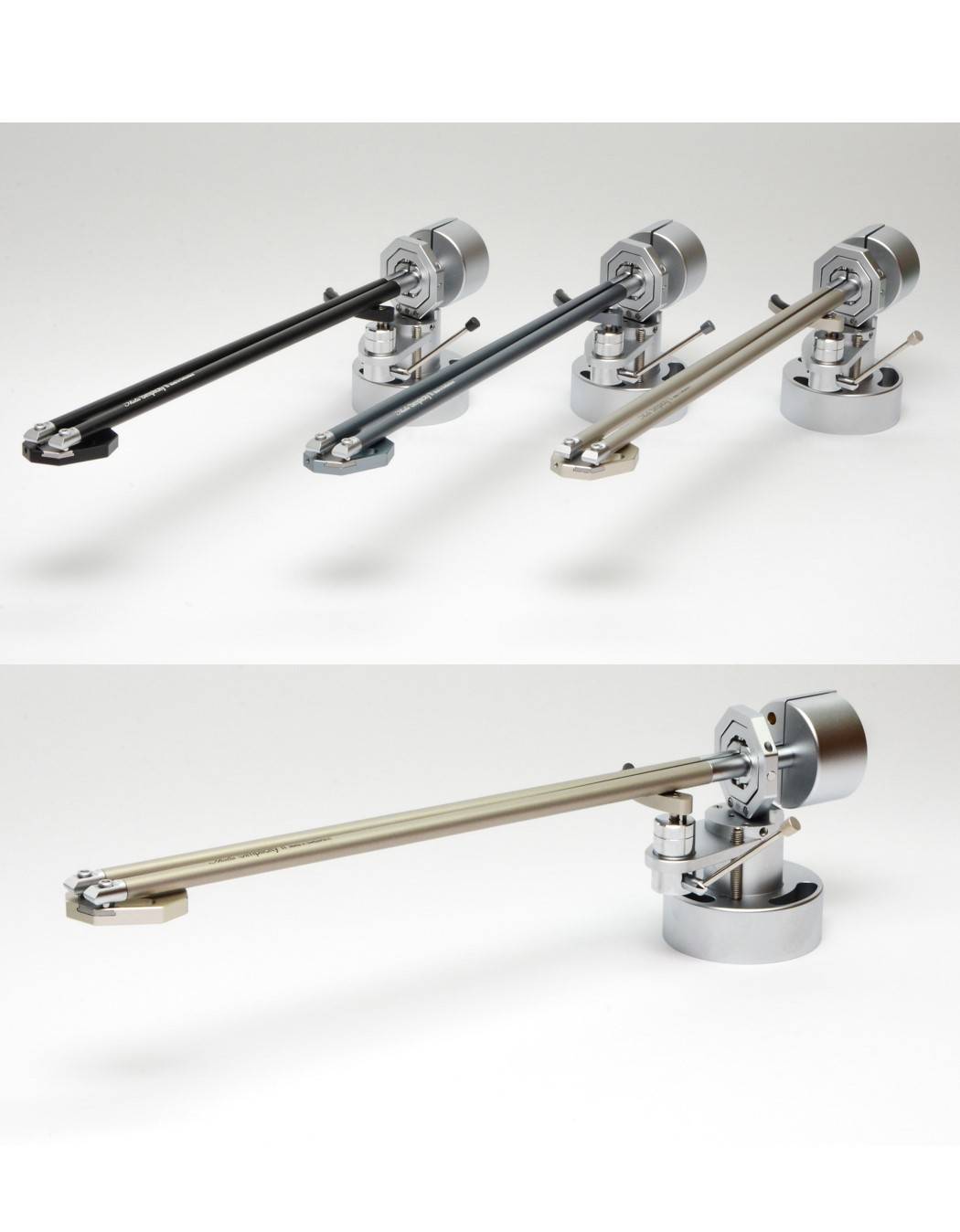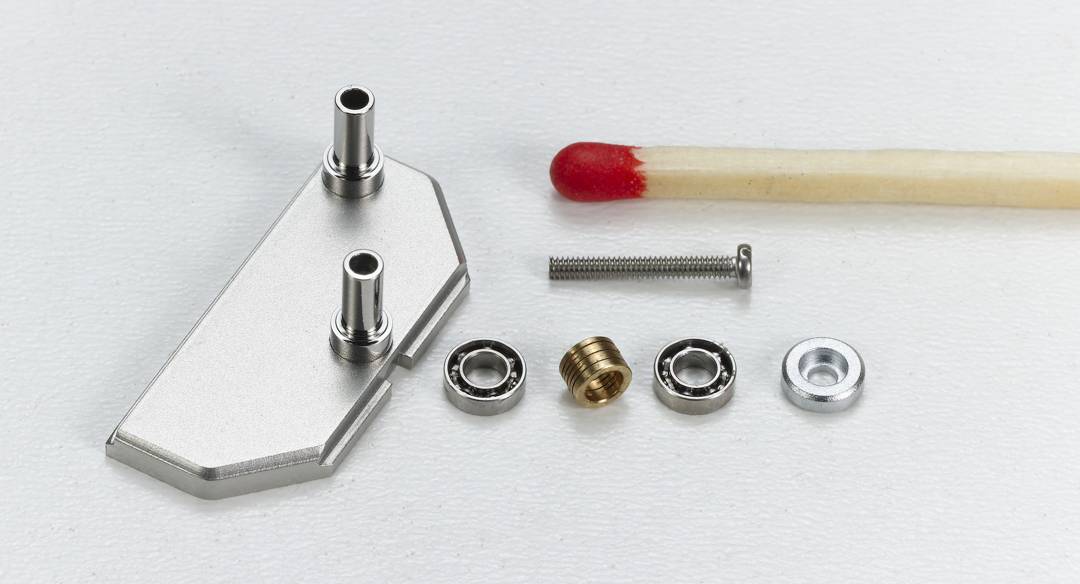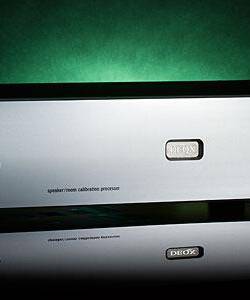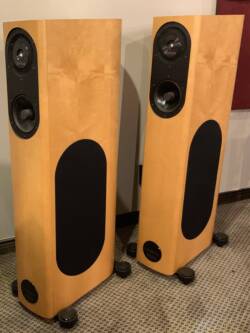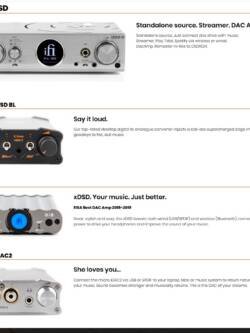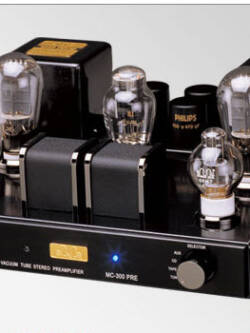Thales Simplicity II Tonearm
Original price was: R280,000.00.R125,000.00Current price is: R125,000.00.
THALES SIMPLICITY II
Thales philosophy is not only to build perfect analogue audio equipment, but also to achieve continuous improvement to set the reference-level in music reproduction. Therefore, we have been working for more than one year to bring our most popular tonearm to be our new reference tonearm.
1. Geometry
By building the two arms slightly longer, the tracking error is reduced to 0,006° while the max. offset angle is reduced to 19°.
2. Bearing
Many long nights of research passed by to create a new bearing technology which combines the advantages of the traditional ruby-bearing (damping properties, one point contact) with the benefits of the ball bearing (load resistant, solid). This TTF technology (Thales Tension Free) is a very clear musical improvement for all our tonearms and has – as a nice side effect – an integrated shock absorbing system for less sensitive handling and transport.
3. VTA
The VTA levelling and clamping mechanism has been improved with two specific mechanical components for sophisticated adjustment and improve the dynamics in sound.
4. Azimuth
The Azimuth can be adjusted accurately ±2° with an adjusting screw.
5. Cartridge alignment Sight unit
The sight unit has an updated reading device for more easy and accurate setting up of the cartridge.
6. Wiring
The internal wiring is guided through both arm-tubes, split for better channel separation. The tonearm has a ground-connection and we provide three different wiring options:
-
Integrated 5 Pin DIN connection
-
Pure wire outlet through the top or bottom for connection to a terminal block
-
Direct wiring which includes the phono cable and RCA or XLR plugs
Mounting information:
-
Spindle to pivot distance: 230mm
-
Effective length: 229mm
-
Effective Mass: 18 grams
-
Maximum tracking error: 0.006 degrees (traditional 9″ tonearm is 2.2 degrees)
-
Maximum offset angle: 0-19 degrees (traditional 9″ tonearm 23 degrees)
-
Cartridge weight: 7g to 23g
-
Armboard cutout hole: 27mm
-
Mounting bolts: 3 x M3
-
Pitch circle diameter: 40mm
-
Height range from armboard to platter (VTA range): min 12mm max 32mm
-
SME compatible arm mount available to fit Simplicity to SME cutout.
-
Colours available: Bronze, Grey, Black
Description
HiFiction Thales TTT-Slim II turntable & Simplicity II tonearm
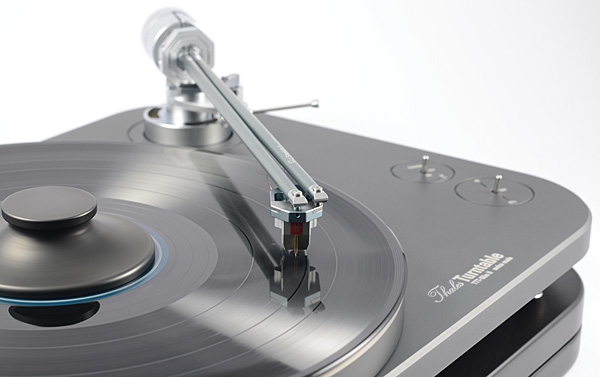
Money, that unreliable buyer of happiness, has at times proven effective at delivering good sound. It can buy other things, as well: Audiophiles can swap cash for products that function as objets d’art, as status symbols, or even as canny investments.But—do you think money can buy peace of mind for the audio enthusiast who frets over binding voice-coils, leaking capacitors, drifting resistor values, oxidizing connectors, aging or incorrectly biased tubes, and that most pernicious worry of all, distortion and premature record wear from incorrectly aligned phono cartridges? Sadly, most of those neuroses, some quite reasonable, remain unaddressed by cash almighty.
Early attempts at solving that last one had promise but failed to deliver. That’s been especially true of straight-line tracking tonearms, which look good in theory but often wind up torqueing the phono-cartridge cantilever to an extent that compromises the newfound tangency and stresses the poor thing’s suspension—one step forward toward peace of mind, two steps back toward audiophile angst. A different path was taken by proponents of the pivoting tangential-tracking tonearm, as originated with the Garrard Zero 100 record player of the 1970s, but that example was compromised by less-than-perfectionist levels of engineering and build quality, not to mention a mindset that disregarded the deleterious effects of resonances and micro rattling.
Pivoting tangential-trackers are once again appearing in showrooms and at shows, none more than those sold under the name Thales, designed by engineer and former watchmaker Micha Huber and manufactured by Swiss company HiFiction. At this writing, there are no fewer than three Thales tonearms—Michael Fremer wrote about their top-of-the-line Statement tonearm ($21,090) in the May 2019 Stereophile—and two similarly distinctive Thales turntables to support them. Earlier this year, Huber sent me the combination of Thales TTT-Slim II turntable (at $6750, the least expensive of his two models) and Simplicity II tonearm (at $9450, in the middle of the Thales line; the two can be bought as a package for $14,180) and suggested I give them a try—which I happily did.
Description
Thales borrows its name from Greek philosopher-mathematician Thales of Miletus (ca 624 BC–ca 545 BC), who noted that in a semicircle, triangles where one vertex is a point on the arc and the other two are at the ends of the arc are, invariably, right triangles. Micha Huber used Thales’s Theorem as the basis for a tonearm whose arc of travel across the record is such that no matter where the stylus lands, that point is the vertex of a right angle that has the axis of the headshell and the radius of an LP as its sides—which precisely duplicates the angle of the mastering lathe’s cutterhead to the master lacquer.
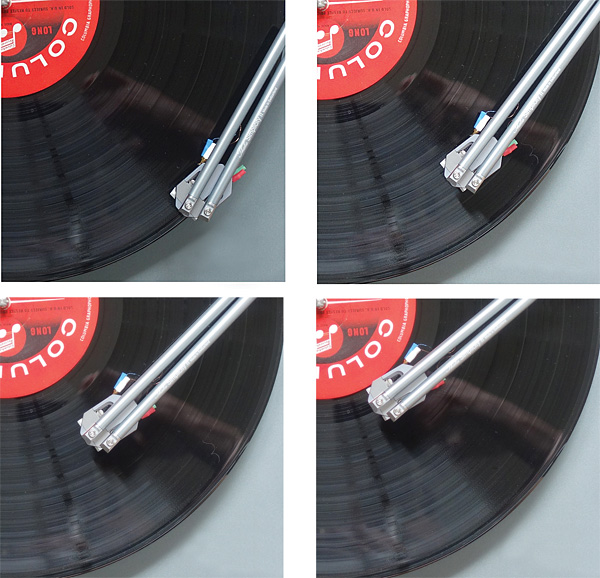
Huber patented this de sign in 2004 and since then has refined its construction to its present realization: a 9″ tonearm comprising two not-quite-parallel aluminum armtubes with an articulated headshell at one end, a split counterweight at the other, and a Gimbal referred to by Thales as a Cardanic bearing—a nod to Gerolamo Cardano, another dead mathematician—at its fulcrum.
In the Simplicity II, the individual bearings that comprise the gimbal, and that enable the headshell’s articulation, are HiFiction’s patented TTF (Thales Tension-Free) bearings. Ostensibly, these are ball-and-race bearings, but their inner races, as well as their axles, are shaped and machined in such a way that they also offer the benefits of single-point jeweled bearings.
The Simplicity II employs a clever split counterweight: Fastened to the rear of each armtube is a weight of semicircular cross-section with a cylindrical auxiliary weight—the position of which determines downforce—fastened only to the inboard armtube. To correct for inconsistent downforce from the beginning of the LP groove to the end, as can result from such a design under the worst of conditions, an eccentrically weighted disc is fastened to the auxiliary weight and can be rotated and then locked in place to compensate for imbalances.
VTA is adjusted in a familiar manner. After loosening the grub screw that secures the arm pillar within the arm-mount collet, the user adjusts a vertically oriented machine screw that passes through the arm gantry and bottoms out in a dimple on said collet; as that screw is turned clockwise, the gantry and thus the arm rise up, and as it is turned counterclockwise, the gantry is lowered. The grub screw is then retightened. Azimuth is adjusted by loosening two lock screws that secure the gimbal to the structure supporting it, then turning a setscrew hidden away in that structure before retightening the lock screws. The Simplicity II does not offer an anti-skating mechanism, perhaps because this arm, with its distinctive geometry, isn’t susceptible to the lateral forces that plague traditional pivoted arms, which rely on generous amounts of stylus overhang and headshell offset to achieve near-tangency. I’ll leave it to the manufacturer—who specifies the Simplicity II’s tracking error as a remarkably low 0.006° maximum—to comment.
At first glance, the very compact TTT-Slim II turntable—it measures only 16.5″ wide by 12″ deep— appears to be a simple, low-mass, solid-plinth design, not unlike so many others available today. Only one of those assumptions proves correct. The platter bearing, drive motor, and tonearm are indeed all fastened to a single structure, but that structure is neither simple nor lightweight: The plinth, like the platter, is machined from solid aluminum—both have a lightly textured anodic finish in anthracite gray—the combination tipping the scales at a surprising 26.4 lb. (Compare that to 13.2 lb for a Rega Planar 3.)
The plinth is machined with a number of hollows and grooves and channels, the largest of these to accommodate its inset platter; as with the classic and no-less-Swiss Thorens TD 124 turntable, the Slim II’s platter mat rises less than an inch above the surface to which the tonearm is mounted. The platter is supported by a machined polymer subplatter, next to which sits a small DC motor that’s isolated from the plinth by means of an intricately shaped mounting apparatus. The metal motor pulley is positioned as close as possible to the edge of the subplatter, to keep the round-cross-section rubber belt as short as possible. Wiring for the motor run through a channel machined for that purpose, which leads to the onboard drive circuitry and battery pack: Although it’s connected to the user’s household AC when its Li-Ion batteries need charging—a running time of 20 hours is specified—the external charger is claimed to be electrically separate from the drive circuitry when the turntable is switched on. That said, in order to prevent any electrical emissions from polluting playback, howsoever slightly, HiFiction recommends disconnecting the charger when it isn’t needed, thus keeping the Slim II off the grid during playback.
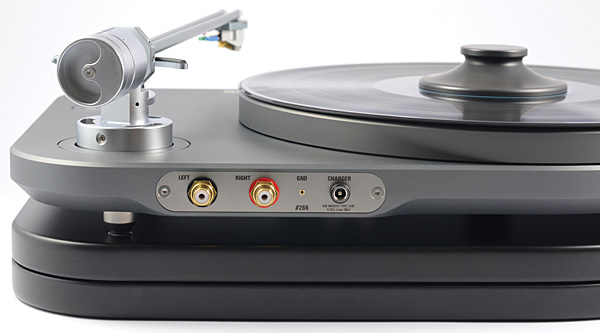
The platter bearing has a well of ductile iron, lined with a sintered bronze bushing that’s said to be saturated with oil during a heated soaking process, guaranteeing maintenance-free operation “for many decades.” The bearing shaft is made of hardened tool steel, hand-polished with basswood and diamond paste. The 7.7 lb platter, machined with a heavy rim to maximize inertial mass, is said to be tuned to one single resonant frequency, then fitted with an inlaid record mat of an unspecified high-density material. (It looks and feels a little like lead, but I’m sure that’s not so.)
The final contributor to the Slim II’s performance is a trio of isolation feet: smallish, height-adjustable fittings in which the contact elements—steel balls—are centered with pliant rubber fittings. The manufacturer suggests that these “spikes” effectively isolate the turntable from horizontal vibrations.
Installation and setup
My review sample of the TTT-Slim IISimplicity II combination was installed in my system, with all apparent skill, by Wynn Wong of HiFiction’s North American distributor, Wynn Audio. That being said, the Thales turntable and tonearm, not to mention their well-executed packaging, seem to have been designed to ensure both ease of setup and consistently precise results.
Nowhere is this more apparent than in the Plexiglas-and-aluminum cartridge-alignment jig—in their very good manual, HiFiction refers to this as a sight unit (footnote 1)—supplied with the Simplicity II: To avoid compromising the arm’s articulating headshell, the design requires that cartridges be mounted on a small aluminum plate that can, more or less quickly and easily, be removed from that headshell, to which it’s locked with a single 0.9mm setscrew. The Thales sight-unit is itself made with a recess into which the cartridge and plate fit—perfectly—and has sight-lines that enable unambiguously correct positioning of the cantilever and stylus. I was impressed that HiFiction invested the effort and care to create such a tool. To borrow a phrase from a soap commercial of yore, Don’t you wish everybody did?
In the weeks following Wynn Wong’s setup, I disassembled the player in part, mostly just to see what makes it tick. And well into the review, I installed the Simplicity II tonearm on my vintage TD 124 turntable (footnote 2). I have now handled, adjusted, and just plain used virtually every element of these two products, and I have to say this: In 34 years of writing about playback gear, I have seen no products better made than the Thales turntable and tonearm, and precious few—that equal them. Indeed, to merely handle the Simplicity II tonearm—to note how utterly free of friction yet also how solid, smooth, and free of play its bearings are—left me in awe of its manufacturing quality. And although I’m far from obsessed over VTA adjustments, I couldn’t help being impressed by how easy it was to adjust arm height. Again, this is accomplished in the same manner as any number of other tonearms of my experience—yet to a one, all are downright crude compared to the way this has been executed on the Simplicity II.
Listening to the TTT-Slim IISimplicity II combination
If only because the Thales record player was so different from my own—small instead of large, new instead of vintage, DC instead of AC, low-torque instead of high-torque— I was a bit startled by how well it performed in many of the performance aspects that are most important to me: color, drive, momentum, sheer juice. I prejudged and came away shocked. There it is.
The Thales combo, equipped with an EMT TSD 15 N SPH cartridge (the standard-mount version of the TSD 15 pickup head), played Sonny Rollins’s “Without a Song,” from The Bridge (RCAJapan Victor RCA-6011), like somebody’s life depended on it: The music lost not one iota of its bounce in the translation from my Garrard 301-based player to this one. And I was especially pleased that Bob Cranshaw’s double bass sounded no less full, and no less snappy, than via my reference player, although the Thales combo lacked the vintage rig’s sense of impact.
But there was more to it than that. In “Without a Song,” during his last break before the bass solo, Rollins plays back-to-back triplets that swim against the song’s rhythmic stream in a manner I’m unable to describe. The Thales player nailed it, just as well as I’m used to hearing from my Garrard (and few others). And in the comparatively pensive “Where Are You,” each one of guitarist Jim Hall’s luxuriantly arpeggiated chords was a pure, tactile delight. Tactile goodness also characterized the piano sound on Herbie Hancock’s debut album, Takin’ Off (Blue Note Cisco 84109), especially Hancock’s solo on “Three Bags Full.”
Lately, I’ve spent a lot of time listening to the Electric Recording Company’s reissue of Henriette Faure’s recording of Book One of Debussy Preludes for solo piano (EMIERC 350 C 004, footnote 3). Thus, I can say with confidence that the Thales player allowed the piano every bit the same (large) scale as my Garrard-based player and conveyed the same eerie languidity, right down to the last weird, disembodied A at the very end. And the Thales combo wasn’t far off the mark in its ability to suggest the instrument’s corporeality, al though my Garrard allowed it to sound meatier still. Another good piano recording—by Reinbert De Leeuw, performing early pieces by Erik Satie (Telefunken 6.42198 AW)—sounded similarly good via the Slim II and Simplicity II, with good weight and concomitantly good scale.
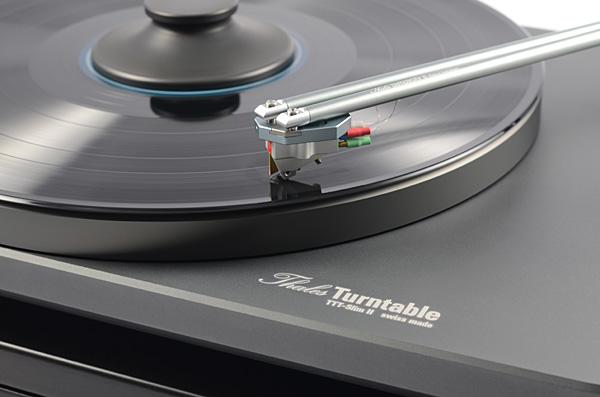
But there’s nothing like Satie’s music, with its reliance on slow tempos and richly voiced sustained chords, to show up speed instability of whatever origin—and my copy of that De Leeuw LP has a bit of a warp in it: I’m accustomed to hearing from it a bit of warp-wow. I went back and forth a number of times between the Thales and Garrard-based players, and there was no question that unwanted pitch variations were less severe through the latter, presumably owing to the greater effective length— 307mm vs the Thales’s 229mm—of my EMT 997 tonearm. All other things being equal, the longer the tonearm, the less severe the audible effects of warped and off-center records.
On one of those freewheeling Saturday mornings when I felt like annoying my neighbor—the one who plants things on my lawn and whose dog is bigger and even barkier than mine—I rooted around for the perfect loud Neil Young song to blast and hit upon the live version of “Ohio” from Journey Through the Past (2 LPs, Reprise 2XS 6480), performed by Crosby, Stills, Nash & Young with Calvin Samuels on bass and Johnny Barbata on drums. On this track, which segues brilliantly from the last note of a live performance of Steve Stills’s “Find the Cost of Freedom” (both songs are in D, played with drop-D tuning on the guitars), Stills and Young both play big, hollow-body Gretsch guitars that seem forever on the verge of feedback—a sound I adore: they scream with thick, sustainy notes that complement the very emotional vocal performances. On the Thales, that all came across as well as I’ve ever heard, along with a fantastically impactful, resonant sound from drummer Johnny Barbata’s ride toms. It was a satisfying and altogether moving experience. No one called the cops.
One of my two favorite versions of the Bruckner Symphony No.8 is the one recorded in 1964 by Eugen Jochum and the Berlin Philharmonic (2 LPs, Deutsche Grammophon 138 91819); my copy is an early tulip pressing, and it sounded thrilling on the Thales. The Wagner tubas in the first movement sounded especially real—at the other end of the dynamic spectrum, so did the very delicate harp playing in the scherzo and the adagio. The Thales combo seemed to do the best it could with DG’s less-than-lushly-textured string sound, but it was the equal of my Garrard in scale.
My only criticism was that the Thales player didn’t equal my reference in its ability to shrug off surface noise. (What is it with DG records from just about any era Is it my bad luck, or were their records less durable than average?)
Listening to the Thorens TD 124Simplicity II combination
Though it may strike some as faint praise, the first thing that impressed me about the sound of the Thales arm on my vintage Thorens was that it maintained my system’s core musical strengths: Lines of notes moved in time with realistic momentum and flow, and neither musical timing nor pitch relationships became the least bit ponderous or unclear—high praise, indeed, considering that I’ve been spoiled by such musically accomplished arms as the Schick, the GrooveMaster II, Sorane ZA-12 and SA-1.2, and, of course, the EMT 997. The scale that opens Maazel and the Vienna Philharmonic’s Sibelius Symphony No.4 (Decca SXL 6236) was as spellbinding as ever. In the chords that open Mendelssohn’s Overture to A Midsummer Night’s Dream, by Peter Maag and the LSO (DeccaSpeakers Corner SXL 2060), the harmonies between the notes played by the flutes and, ultimately, the oboes, clarinets, bassoons, and horn, sounded true, not sour. And the moderate swing tempo of Frank Sinatra’s “Oh, You Crazy Moon,” from Moonlight Sinatra (Reprise FS-1018), was propelled by relentless rhythm guitar and drum kit, sufficiently steady that Sinatra’s own timing shifts dazzled rather than annoyed.
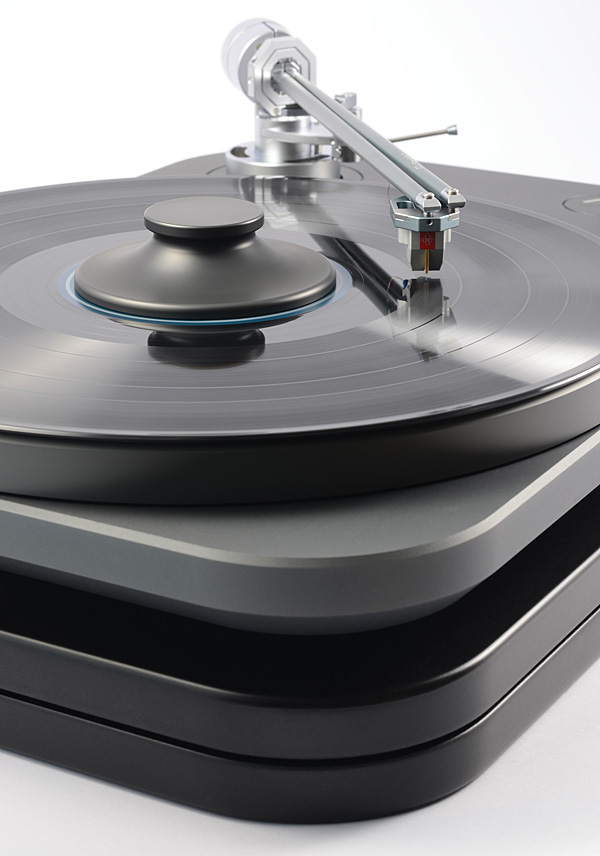
Among the other records I tried was a long-time favorite: 1979’s Manzanita, by the Tony Rice Unit (Rounder 0092). Apart from his groundbreaking lead work, guitarist Rice is celebrated by fellow musicians for his no-less-accomplished rhythm playing, characterized by a unique combination of fluidity and hard-charging momentum. The Thorens-Thales combination perfectly captured that sound—in both Rice’s playing and its real-time influence on the other musicians in the ensemble—on “Blue Railroad Train” and others. No less delightful was the way this combination reproduced the tautly sustained notes from Todd Phillips’ double bass on “Midnight on the Stormy Deep” and highlighted the stylistic differences between David Grisman and Sam Bush’s mandolin playing throughout the album.
Conclusions
In the sense that I’m accustomed to thinking that the ultimate in involving playback is the sole province of high-torque idler-drive turntables and transcription-length tonearms—and of phono setups that require hours of painstaking tonearm and pickup alignment—the combination of TTT-Slim II turntable and Simplicity II tonearm was a surprise, and a very pleasant one. While it never delivered the sheer impact I continue to associate with old-style low-compliance pickup heads, both stereo and mono, it consistently played music in a way that captured and held my attention and brought out most of the things I love about my favorite records.
I admit coming away from this review thinking of the Thales tonearm as the star of the show: Just as the above-mentioned Sorane tonearms transformed my lovely old Thorens TD 124 into a drivemeister of a player that all but rivaled my Garrard 301’s ability to communicate music’s sheer physicality, the Thales Simplicity II enhanced its ability to play lines with musical clarity and nearly hypnotic momentum and flow: playback that was just as involving, but in a slightly different way. And it must be said: The Thales Simplicity II is nothing less than the most well-made tonearm I’ve ever used.
While the Thales products aren’t cheap, they betray a level of craftsmanship that’s hard to find in any consumer product—that and an engineering approach that’s as conservative as it is original: What else can you say about a designer who, unlike so many competitors, can make a turntable this good without having to make it grotesquely, uselessly big?
Especially for the user who prefers standard-mount cartridges over old-style pickup heads—a group that surely includes the vast majority of phonophiles—the Thales player, and especially the Thales tonearm, absolutely must be given serious consideration by anyone whose budget can stretch this far.
Thales Simplicity II Tonearm | REVIEW
December 16, 2018

On March 27th, 1983, the New York Times published an article titled “Sound; Tonearms: Is Linear Better?”. The article read like a technical paper, more sophisticated than some of today’s articles found in Audiophile magazines. Without too much introduction, the article jumped right into contrasting the pros and cons between tangential versus pivoted tonearms as if it was normal kitchen table talk. But when Sony released the first commercial CD player in 1982, the sale of turntable equipment dwindled in popularity together with vinyl, and the article was the last time mainstream media provided technical coverage on turntable technology.
Words and Photos by Richard Mak
Tonearm technology, however, never ceased to progress and continued to develop throughout the CD-dominated era of the ’90s and on into the current era. That is, the subject of the New York Times’ 1983 article is still relevant today.
Most tonearm designs fall into one of two categories: Pivoted Tonearms and Linear Trackers. Pivoted tonearms, as the name suggest, swings across the record surface swiveling on a single point. They are usually simple in design and have the advantage of having few moving parts other than the bearings. But due to the offset angle of the cartridge, the stylus’ does not remain tangent to the record surface as it moves from the outer edge towards the label. The number of degrees by which the cartridge angle differs from true tangent at any particular moment of the play is called the tracking error. This difference makes the stylus ride askew in the record groove, causing distortion, and is somewhat analogous to the sideways drag caused by bad wheel alignment in a car. This distortion can sometimes be audible, where you can hear the sound “breaking up” as it comes out of the speakers.
Linear tracking tonearms, in contrast, do not swing across a record. Instead, the arm slowly crawls over the record in a straight radial line, inching its way toward the center label. The stylus remains tangential to the groove walls, and the angle stands constant, eliminating tracking errors (at least in theory), but that’s not the only benefit. Linear tracking also eliminates the side-thrust called the skating force, which makes conventional arms lean harder against one side of the groove than the other. This force is caused by the offset angle for the headshell in pivoted arms. Linear arms have no such offset angle, so the problem never arises in the first place (again, at least in theory) so they require no anti-skating adjustment.
Yet, linear tracking tonearms are not without their shortcomings. It takes a complex mechanism to guide the linear arm across a rail (in order to maintain that “correct” angle), and the vast majority of such implementations require complex air bearings, pumps and pressure monitors, and an air compressor. Manufacturers of “air bearing” tonearms will often claim they are frictionless, but regardless of their claim, the ability of the arm to glide across the rail rest solely on the record grooves and the stylus resting at an angle least efficient for energy transfer, typically at 90 degrees. Over time, the stylus on many linear tracking arms are found to have uneven wear on one side of the diamond, and some cartridge cantilevers are also found to be skewed towards one side.
There is a third alternative, which brings us the subject of our review today: Pivoted Tangential tonearms, namely the Thales Simplicity II (US$ 9,450).
In Asia, Thales’ pivoted tangential arms are nicknamed “the Chopstick Arm” for good reasons. By using two armwands instead of one, pivoted tangential adjust the position of the headshell as it swings across the LP so that the stylus always maintain a tangential position. The tracking error is said to mimic tangential arms almost completely. On the Thales Simplicity II and the statement, the tracking error is said to be only 0.006 degrees.
The concept may seem very advanced, but Thales is not the first to come up with this concept. The design was introduced as early as 1956 by ESL BJ’s “Super 90” tonearm which employs the same technology. The owner’s manual of the ESL BJ arm gave a very comprehensive explanation of the pivoted tangential concept together with diagrams:



While both the BJ Arm and the Thales arm employs 2 armwands, the BJ Arm is based on the “Tetragon” geometry while Thales arm is based on the “Triangle Geometry”, which reduces tracking error to a level much lower than the BJ arm.
Aesthetically, the ESL BJ “Super 90” has a 1950s chic; it looks like a ’70s Star Trek Klingon spaceship guided in front by a flying cockroach. Regardless of how amazing it may sound, you will never catch me with a BJ arm playing on my table, especially with the letters “BJ” (signifies the designer’s name Burne Jones) is printed big right on the headshell. Lets’ just say that the “aesthetic joy” is relatively low.
The Thales Simplicty II, in contrast, is a modern work of art, which combines Swiss elegance with high precision machining. I must admit, as soon as I opened the box, I was captivated by the looks of the Thales Simplicity II and immediately purchased the review sample before I even mounted it.
Mounting the Thales Simplicity II
As the model name suggests, the Thales Simplicity II is one of the easiest tonearms to mount, and it comes a detailed instruction manual. It comes with an acrylic mounting guide which locks the arm into 1 position with no play whatsoever. You simply swing the arm-board to a spot where the mounting guide locks the arm into place. The tonearm comes with 3 counterweights which supposedly will give you infinite possibilities with cartridge matching. It took me quite a while to find the right combination for my Clearaudio Titanium II cartridge.
Unlike conventional tonearms, the cartridge mounting process does not require a mounting template such as the SMARTractor, or Feickert Protractor. It comes with a device which Thales calls the “Sight Unit”. You are to insert the cartridge onto the headshell and then align the cartridge’s proper position by viewing the position of the cantilever versus the grid lines on the sight unit.

Be cautious that you do not tilt the sight unit because the headshell can easily slide out. I tilted the unit and it came sliding out unexpectedly, and if had landed on the cantilever it surely would have been snapped! I recommend taping the end with green tape to prevent an “Oh Shit” scenario.
This alignment process is tantamount to the accuracy of the entire setup, as the proper implementation of the pivoted tangential theory rests entirely upon this very step. If the alignment is wrong, it will cause the stylus’ tracking angle to be wrong throughout the entire record surface. The stylus’ “bulls-eye” on the Sight Device is a round circle 1mm in diameter, I would much prefer to see a tiny dot, or a crossing of the gridlines on the acrylic surface the same way Acoustical System did with the SMARTractor, which in my opinion will greatly improve accuracy. With a round circle, it makes sighting the exact location of the bulls-eye a little tricky. It took me nearly 20 mins of wiggling the cartridge back and forth before I locked it into position. Once locked into place, the headshell slides easily onto the tonearm’s headpiece and is secured with a 0.9 size tiny Allen key.

Because no alignment is performed at the tonearm level, you can quickly change to another cartridge by simply sliding in another headshell. Extra heahshells can be purchased from Thales at US$ 350.
Azimuth, VTA and the Whole Enchilada
Azimuth adjustment on the Thales tonearm is not as easy as the mounting process. You need to use the provided, long but small-sized slotted screwdriver to loosen the two tiny screws in front, azimuth is changed when you turn the set screw on the side with an Allen wrench. A spring is loaded on one side only, so it makes adjusting one direction easier than the other. However, adjusting the azimuth changes the entire plane of the multiple bearing pivots on the column, once it is adjusted out of position, it takes a bit of patience to get it back to perfectly horizontal position. The set screw also travels more on one side, which allows you to tilt the cartridge a lot more to the right but not so much to the left.
The vertical tracking angle is fairly easy to adjust, and it employs the same mechanism as DaVinci Virtu and Grandezza. You basically adjust the height by changing the setscrew. However, it is important to note the Azimuth will remain perfectly flat in one single VTA position only, due to the offset angle of the headshell, as soon as you change the VTA the Azimuth angle will no longer remain the same, and you will need to realign the Azimuth. This is true for all tonearms with a cartridge offset angle, but with the dual armwand design the effect appears to be slightly more pronounced on the Thales Simplicity II so care must be taken to re-adjust azimuth after changing the VTA level.
Even though the Simplicty II do track tangentially, their offset angle will require compensation of the skating force. The Thales Simplicity II is designed with a fixed amount of anti-skating force which is not user adjustable, which basically means you are at the mercy of the inherent fixed setting. Using the AnalogMagik alignment software, there was a negligible amount of distortions between L and R channel using the Anti-Skating function on my Clearaudio Titanium II and Goldfinger Statement cartridge which suggests anti-skating force is not needed (Both cartridges track at 2.87g). But on the Kondo IO-M as well as the My Sonic Lab BC, there was an imbalance in total harmonic distortion between channels which meant it could benefit from an adjustable anti-skating.
Lastly, it is important to pay attention to the position of the rotatable “U” shape eccentric counterweight. Due to the dual armwand design of the tonearm, the stylus tracking force may be uneven across the LP surface. If the tracking force increases or decreases towards the center, you can counterbalance it by rotating the eccentric counterweight. You will need to measure VTF on multiple points on the platter, the entire process took me a bit of time to achieve a somewhat balanced level of VTF across multiple measuring points.
The Sound of Simplicity
I first mounted the Thales Simplicity II onto my TW Acustic Raven AC with the Black Knight copper platter and a Tenor Phono stage. It is a combination which I have tried over 30+ tonearms and 30+ cartridges with, so I am quite capable of detecting the slightly sonic changes brought on by any new equipment. I first mounted the ZYX Universe Optimum 1 Ohm cartridge onto the Simplicity II. The sound is unmistakably conservative yet composed, it reminds me of the sonic signatures of the Triplanar tonearm. It is not as lively or as extended as the 12” Schröder Reference Ebony, or the Graham Phantom II Supreme B52 12”, both of which which sits beside it on the TW Raven AC. At the same time, it is not so far off to the other spectrum, versus say the Ortofon RS309D or the old SMR 3012R, probably somewhere in the middle. It projects a tonality that is well balanced and a sonic image that is composed and stable, without exaggeration of the frequency extremes.
With its proclaimed low tracking errors, I pulled out some of the most challenging LPs to track with ordinary pivoted tonearm to see if the Thales Simplicity II will suffice. The final movement, Apparition d’Endymion, on side 4 of Delibes “Sylvia” Ballet (DECCA SXL6635/6) has an explosive passage near the inner grooves which can exhibit audible distortions for many 9” tonearms, the Simplicity II managed to play through the three separate bass crescendos without the slightest hint of distortions. I then pulled out two recordings which are even more challenging than the Sylvia LP. The first is Ester Ofarim’s famous Esther album (ATR 001). The last song on side A, “Una Matica De Ruda” is recorded unusually close to the inner grooves, and whenever I play this with 9” tonearms, the tracking error is so great that the right channel will start breaking up. Again, Simplicity II could play through the track with almost no distortion on the right channel compared to all my other 9” tonearms. Ofarim’s voice is seductive and captivating, but most importantly, distortion-free for the first time! Wow! What an accomplishment!
Then, of course, the final test is none other than Rhymoi Music’s epic production by Chinese recording engineer Li Xiaopei, the Song of Songs album (RMLP-007). Although sharing the same tile as King Solomon’s “Song of Songs” of the Holy Bible, they actually share no historical roots or commonality. The very last song of the album “The Whole River Red” (Proper translation should be The Crimson River) is a heroic battle song which portrays the inner struggle of a young soldier during the fall of the Song Dynasty. Loud rhythmic music of cymbals, drums, and strings are climaxed together with Chinese Opera Singer Guan Dongtian’s tenor voice near the end of the track, often resulting in audible distortion caused by tracking errors. The Thales Simplicity II is indeed a tonearm worthy of this epical production. The entire song was rendered solid and stable imagery, well-defined instrument separation and most importantly, an undistorted voice which fully conveying the tenor’s heroic emotions. The Simplicity passed all the tracking test with flying colors!

I then moved the Thales Simplicity II over to the Artisan Fidelity turntable and mounted it with a Kondo IO-M cartridge. The combination proved to be less than satisfactory as the calm and conservative character of the Simplicity II was not a good match with the Kondo IO-M’s voluptuous and bloomy midrange. The sound did not come alive. Anti-skating measurements also weren’t satisfactory on AnalogMagik, with noticeable THD% imbalance between channels, so I quickly substituted it with the Clearaudio Titanium V2 cartridge.
The exercise proved to be rewarding as it was close to a perfect match. The dynamic and robust character of the Titanium V2, combined with the Simplicity II’s conservative traits, delivered a near perfect tonal balance and with good frequency extensions, which goes to show the importance of finding the right cartridge combination.
I particularly enjoy playing Chabrier’s España, with Ataulfo Argenta directing the LSO (DECCA SXL 2020 ED1) as well as Manuel de Falla’s Three-Cornered Hat (DECCA SXL 2296 ED3), both recordings can oftentimes sound brassy, tipped up and fragmented, which was exactly what happens when I play it on the Graham Phantom II Supreme B51 12” arm with the same cartridge. The Thales Simplicity II gave it just enough control to project a sound which takes away the harsh elements, yet without robbing too much of the liveliness and dynamic contrast. Conservatism can sometimes be a good thing!

Towards the end of September, my business travels took me to the famed Analogue Fellowship of Malaysia, I was deeply honored to have spent two days with Dato Danon Han Hong Den, who is the President of Analogue Fellowship. Dato Danon Den was kind enough take me to see some of the world’s finest audio setups in Kuala Lumpur and Ipoh (A city 2 hours outside of KL).
One of most memorable visits I had was at Mr. Ben Tan’s house in the heart of Kuala Lumpur. There I witnessed one of the finest sounding systems where the Thales Simplicity II was deployed. Mr. Tan has the exact turntable as I have, the TW Raven AC turntable, mounted with the Simplicity arm. The rest of the system include the Focal Grand Utopia EM EVOnspeakers, and Krell Electronics.
We went back and forth between the Thales Simplicity II, putting it up against some very stiff competition, including the Clearaudio Reference Linear tracker. The Simplicity did not disappoint, it reproduced a sound which was lively and unrestricted, much more so than the sound which I can achieve in my Peak Consult Dragon Legend and McIntosh based system. Again, this goes to show the importance of proper equipment matching.
We played music from Chinese opera to Jim Reeves, to chamber music, to grand orchestral pieces. The entire system is much faster, more upfront and robust system than what I am accustomed to hearing from my McIntosh and Peak Consult combo. The Thales Simplicity II gave the sound just enough control and composure to balance out the aggressive aspect of the system, resulting in a tonal balance which provided just enough color and weightiness to the holographic image, yet not pushing it over the edge where it becomes overly sharp or bright. It is natural and unexaggerated, a sound which is forever imprinted in my brain because it is one most satisfying performances I have ever encountered.

Conclusion
At the end of this review, I shall thank Wynn Wong, CEO of Wynn Audio (Canadian Distributor of Thales Tonearms) for giving me the opportunity to review this fine Swiss instrument. I must also apologize for the apparent long delay in the publication of this review due in part to heart surgery. However, the delay may turn out to be a good thing as I caught a glimpse of the newly released Thales Statement which was debuted at the 2018 Toronto Audiofest. Apparently, improvements have been made to the armwand material, the multiple bearings, the azimuth as well as the VTA adjustment. At a list price of $ 21,090, the Simplicity Statement is more than double the price of the Thales Simplicity II, it is approaching a territory which few can afford to venture into. With the Thales Simplicity II, I am proud to say I have fully experienced the “Pivoted Tangential” tonearm technology and have come away satisfied, but at only half the price of the Statement model. With the right cartridge and turntable combination, I am sure you can also be a happy camper.
